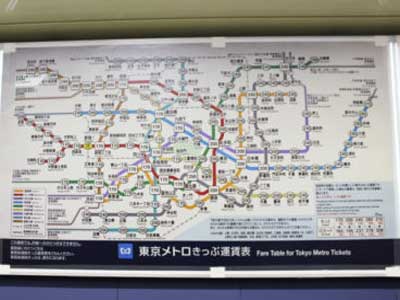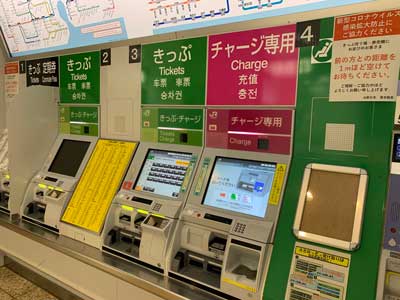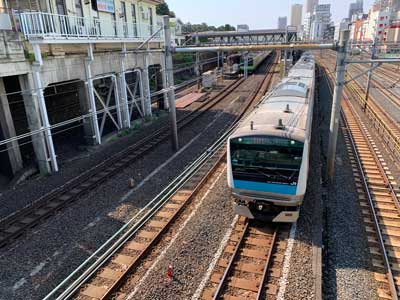If you come to Japan as a tourist, chances are you will take the train and metro regularly. The train in Japan is run by JR, which means Japan Railways, and is the railway company that is owned by the government. JR is spread all over the country in a large network.
Metro is privately owned and only runs in and around central Tokyo, but if you are in Tokyo and don’t know what to look for it is hard to see the difference between JR trains and Metro lines. A good way to tell them apart is to look at the shape of the station indicator; if it is square it is a JR line, and if it is round it is a Metro or other privately owned company’s line.
Japan’s railway system is known for being the world’s most reliable and punctual train system, and you will surely feel for yourself how convenient this smoothly running system is.



Train and Metro Tickets, Passes, and Cards
Depending on how often you are going to be using public transportation during your stay in Japan, it is either best to purchase a single ticket, a one-day pass, or a Suica or Pasmo card. Please also note that if you travel with kids between 6-12 years old, they can always get a ticket at half the price. Kids under 6 travel for free without a ticket.
If you are only going to be paying for your train ticket once or twice because you, for example, booked a rental car for most of your stay or will have a valid JR pass for the rest of your stay, it is best to buy a single ticket. Tickets can be purchased at the machines located next to or near the ticket gates. You can use them in English by selecting the button that says ‘English’ that is commonly located in the upper left or right corner.
You need to look at the map that is usually above your head to see the price mentioned at the station you want to go to and choose that ticket price on the screen. Don’t worry too much about making a mistake, if you accidentally don’t pay enough you can pay the difference at the window at the station where you get off. You don’t have to pay any fine for that.
Single Tickets and Day Passes
If you are planning to travel a lot with JR lines on that day, but you don’t have a valid JR pass (yet), you can buy a day pass for only 750 yen that will let you use the JR lines within the city an unlimited amount of times. It is worth buying this pass if you are planning to take at least 3 trains that day. You can buy this pass in the ticket machine as well, it is usually under a button called ‘value ticket’.
The same goes for Metro tickets, depending on the places you want to visit you can also try to stick with just using Metro lines for the day and buy their 600-yen value ticket. Metro also has 2-day and 3-day passes for sale, but these can only be bought on a limited number of locations like large tourist information centers.
Then there are the value combination tickets that let you use both Metro and Toei lines for the day, or that let you use JR, Metro and Toei lines for the day. These tickets are a bit pricier though, and in general, just getting the one-day pass for either JR or Metro is enough.
Train and Metro IC Cards
If you are planning to use public transportation a lot for at least 2 or 3 days during your stay, it pays off to buy a Suica or Pasmo card. You can also buy these in the ticket machines, they cost 500 yen for the deposit which you can get 250 yen back from if you hand your Suica or Pasmo pass back before leaving Japan. Please note that this can only be done at certain stations, and only in Tokyo for Pasmo.
You can also choose to keep it, as you can use it for 10 years, and you can also give it away to someone else who is coming to Japan. This IC card can be charged with cash, and each time the balance runs low you can top it up at almost any machine at any station.
The great thing about IC cards is that you can use them for any mode of transportation (train, metro, bus, boat) all over Japan, and you can also use the card as a cash card in many convenience stores, restaurants, vending machines, and shops. You also don’t have to look up your fare for each trip anymore as the right amount will automatically be deducted.
This also makes switching between trains and metros easier. Please note that there are different IC cards besides Suica and Pasmo like Icoca and Manaca, but it doesn’t matter which one you get as they all work the same since the system got overhauled in 2013.



The Ticket Gate and Beyond
Using the ticket gate is simple. If you have a single ticket or a day pass, you have to enter it at the front and take it back at the other side of the gate. Don’t forget to do this, as otherwise, you won’t be able to get out of the destination station. Once you get to your destination you enter the ticket again and it will usually be swallowed by the machine. If it does come back, you should take it out so the next person can use the gate.
If you have an IC card, you just have to tap in at your entry station. And then you tap out when you exit your destination station and on some transfers.
If you have a valid JR pass, you always have to go past the manned window and show your pass to the employee.
You can easily find the right platform by following the signs, it is good to remember the end station of the line you are taking, and you can also use Google maps to know what your platform number is. When you line up it is common courtesy to make use of the lines on the floor. In general, it is least crowded in the first and last few cars of the train.
When the incoming train stops, you will have to wait until everyone has gone out. This is sometimes really fascinating to see, especially if the train is completely crowded. Once you get on the train, it is recommended to move to the sides of the car to free space in the middle.
Your Japan Tour
As seasoned Japan experts, we create perfect Japan package tours including guides who make your trip smooth and educational. Check out our group tours and private tours, or contact us to start planning your unforgettable holiday to this fascinating country. Japan is full of once-in-a-lifetime experiences, culture, history, nature, and delicious food!